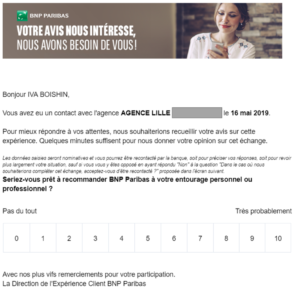 With the intense competition in the banking sector, companies are looking for ways to retain current and entice future customers. Because interest rates are already at a very low rate and various promotions make banking free (which is not normally the case in Europe), banks are looking for some non-monetary reasons to encourage customers to use their service. These banks seem to be doubling down on customer service.
With the intense competition in the banking sector, companies are looking for ways to retain current and entice future customers. Because interest rates are already at a very low rate and various promotions make banking free (which is not normally the case in Europe), banks are looking for some non-monetary reasons to encourage customers to use their service. These banks seem to be doubling down on customer service.
The last time that I had a meeting at my bank, I received an email the day after asking me to fill out a customer service survey. With the popularization of big data analysis, this practice of collecting as much feedback from customers is becoming rather popular. Survey responses are becoming more insightful as big data analysis can not only provide descriptive statistics outlining a screenshot of where the company is now, but it could also offer predictive and prescriptive analytics through machine learning and natural language processing. Machine learning can for example help companies determine which customer service aspects are most important in determining the level of engagement of a consumer. As a result, companies can use this analysis to ensure that those aspects are up to par in order to be viewed positively by their consumers. Moreover, natural language processing can be used to determine the overall feeling of the comments and to see if there is a particular topic that comes up with any particular group of clients.
In order to perform these analytics, though, banks need to first convince customers to fill out the surveys. BNP did this very effectively through their email, in my opinion. In a world where everyone is constantly rating everything in their life, sending an email asking the customer to rate their experience gives the customer the power to be on the giving side instead of the receiving side. This response then takes the customer to the actual survey website. Feeling like they have already started, the customer completes the survey, as it is human nature to ignore the principle of sunk cost. This is much more effective than simply having a CTA saying “Take the Customer Satisfaction Survey Now”. This CTA gives the customer the impression that they have yet another thing on their to do list instead of smoothly transitioning them from reading their email to answering the customer survey.
Have you noticed any difference between the emails in which you take action and the ones in which you do not? What was the difference in the emails?